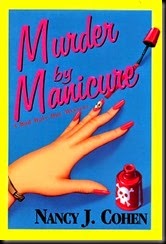How do you formulate a traditional murder mystery plot? Do you start with the victim? The villain? Or do you select an evocative location or a controversial issue and start there?
I’ll clue you in to my methodology. This might work differently for you and is by no means a comprehensive list. But these are the elements I consider when planning a mystery. It’s part of what I call the Discovery phase of writing.
Book Title
Do you title your story before or after you write the book? I prefer to have a title up front. Sometimes, this dictates what I have to do next. For example, in Murder by Manicure, I had a title and no plot.
This had been part of a three-book contract, and all of a sudden my publisher wanted a synopsis. I had to come up with an idea that incorporated the title. Someone had to die either while getting a manicure or as a result of one. I face this same quandary now. I have the title, and I have to suit the crime to this situation. That brings us to the next element.
The Crime Scene
Do you begin with the victim or the villain? In a psychological suspense story, you might begin with the villain and why he became that way. The focus would be on how he turned to the dark side and what motivates him now. Then in comes your hero who has to figure out a way to stop him while delving into his psyche at the same time.
My plots center around the victim. Who is this person? Where do they die? How do they die? Once I figure out the Howdunit, I’ll move on to the next factor.
The Victim
What made this person a target? Here we might learn about their job and personal relationships. Was this person loved without a single blemish in his past? Or did other people have reason to resent him? What might have happened in his past to lead up to this moment? And what did he do to trigger the killer at this point in time? What could he be involved in that you as a writer might want to research?
The Cause
This is the passionate belief that underlies your story. It’s what gets me excited about a book, because I can learn something new and feel strongly about an issue while weaving it into my tale. In Hanging by a Hair, I deal with condo associations and their strict rules. I also touch upon Preppers and the extremes they go to in their survivalist beliefs. Or perhaps my theme is really about family unity, and how Marla strives to bring peace to the neighborhood so she can resume a normal family life. In my current plot, I finally hit upon The Cause. Now the elements are starting to come together. It’s exciting when this happens. And that brings us to the next factor.
The Suspects
Who has the motive, means and opportunity to have committed the crime? Does every one of your suspects have a viable motive? If so, whodunit? And why now? How can you relate these people to each other? This is the fun part, where the relationships build and the plot begins to coalesce in your mind. Character profiles might help at this stage, so you have a better concept of each person before they step on stage. Seek out photos if necessary and do any research you might need before you get started writing. What does The Cause mean to these people? Is it the reason why the victim had to die? Or is it the glue the sleuth will use to put the pieces together?
Personal Threads
Now focus on the sleuth. If this is your first story in a series, you’ll want to do an initial character profile. But like me, if you’re well into a series, you already know the hero or heroine. However, the protagonist needs to grow or change with each story, so what will be their personal lesson this time around? What is at stake that draws them into solving the crime? How does it affect them personally? And what other issues in their life are they dealing with now? What is their personal arc going forward?
Hook the Reader
Where will your story begin? How will it end? Will you include teasers for the next story? Even if you’re a pantser rather than a plotter, you’ll want to have an idea of a path to follow.
For me, by the time I’ve reached this last part, I have already jotted down plenty of notes. They might even be starting to make sense. I’ve done preliminary research and can see how the suspects relate to each other. Now it’s time to sit at the computer and write the synopsis. This should show personal conflicts as well as plot points, and how each story development affects your protagonist. You may follow an entirely different process, and that’s fine.
So start with various ideas for your plot. Write them down. Do a bit of research. Sound out your plot points to critique partners or friends. Identify the victim, the crime scene, and the manner of death. Develop your list of suspects. And then you’re off and running. For me, this is when the actual story starts. It’s begins with a crisis or murder that draws your sleuth in to solve the crime. Everything should flow logically from there.





Hi, Nancy,
As usual, your explanations are helpful to other writers. I agree with you that in a series the sleuth must develop and change in character just as people do in real life. Static characters are dull and unrealistic.
You’re right, Jacqueline. If you think about it, Nancy Drew never changed, at least while I read the series. Her adventures were fun but there wasn’t much emotional depth.
Very clear and succinct, Nancy! My new project is a full-on murder mystery, and your comments give me a new way of looking at these elements. Well done, and thanks!
I’m glad you found my comments to be useful, Lloyd. Good luck with your story.
Good reminder! I’m writing a murder mystery with time travel–the corpse is found at the beginning, but it was sent back in time. So now the heroes are racing to solve the mystery before the clock ticks down and they catch up to the murderer.
It’s been insane to write, but it’s draft 5 and I think I’m finally getting it the way I want. 🙂
A time travel murder mystery sounds both intriguing and challenging. Good luck with this project!
I love adding mystery elements to my thriller plots. At times they come in a subplot. I like giving a face to the victim, making their lives matter even after they’re dead. No cardboard bodies used only for pace. Good post, Nancy.
Yes, we have to remember that the victim’s life mattered to someone and not gloss over their loss.
Pssst. Look for the cuticle killer. I hear he has a long file.
Good one, Jordan!
So glad this came in my in-box today. I’m in the Discovery Phase of the next book in my series and these are such good suggestions.
Cool, Patricia! Wishing you well as you discover your plot.
Nancy,
All great reminders of what goes into the mystery elements and characters. I also love a good dose of secrets.
Yes, I like to give each character a secret. Then they seem suspicious even if it’s a good secret, like paying for an aunt in a nursing home.
Thanks for these great reminders. I’m reading Low Pressure by Sandra Brown right now. I swear, everyone is a suspect in this book, including the mc!
Sandra Brown is a wonderful writer. I was reading her when she wrote romance.
Great tips, Nancy! You’ve given mystery writers and aspiring authors lots of good stuff to think about. Thanks for sharing.
These are only the basics but it’s enough to get one started. The planning stage can sometimes take as long as writing the book.
Thanks for this nice, clear description of how you shape your stories. I tend to have trouble writing from an outline or synopsis, but I like the way you’ve broken down the main components.
Starting with a title is a bit strange for me. My titles evolve as the book progresses. But, even saying that, my current WIP has a title and did so from the get-go. So, go figure. 🙂
I’ll save this nice post to inspire me to be more methodical next time!
If you want to go into more detail, take a look at my Writing the Cozy Mystery booklet. Plus don’t forget the benefit of critique partners who can brainstorm with you.
What a great post, Nancy. I never fail to learn something new — or be reminded of what I should already know — when I read your blogs on writing. Thanks so much.
Thank you, Mary, for stopping by!
Excellent post and advice, Nancy. I’m glad stopped in because you gave me a few things to think about. Thank you!
Marja McGraw
As a former newspaper reporter, I harken back to real homicides, then doll them up. I get new ideas everyday on the jump page of any city paper. Broadcast news stories don’t give me enough pulp. Truth is stranger than fiction, they say, except fiction has to have an element of truth to be believable. Strange! I enjoy the unexpected.